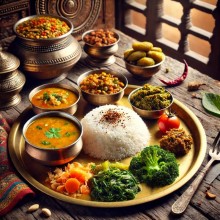Nepal’s culinary heritage is deeply rooted in tradition, with each region offering unique, wholesome dishes crafted from fresh, seasonal ingredients. From the comforting dal bhat of the lowlands to the nutrient-packed dhindo of the hills, our ancestors followed a diet that naturally supported health and well-being. However, with urbanization, processed foods, and changing lifestyles, chronic illnesses like diabetes, hypertension, and heart disease are on the rise. By embracing traditional wisdom while making mindful adjustments, Nepali families can cultivate sustainable eating habits that promote long-term health.
1. Reviving Traditional Nepali Meals with a Healthy Approach
Dal Bhat: The Classic Balanced Meal
A staple of Nepali households, dal bhat tarkari is already a well-rounded meal when prepared thoughtfully:
-
Dal (Lentils): A rich source of protein; incorporating varieties like masoor, moong, or rajma adds diverse nutrients.
-
Bhat (Rice): Opt for brown or unpolished rice to increase fiber intake.
-
Tarkari (Vegetables): Incorporate at least two seasonal vegetables like saag, pumpkin, or cauliflower for essential vitamins and minerals.
-
Achar (Pickle): Choose fermented options such as gundruk or sinki instead of overly salty or oily pickles for probiotic benefits.
Healthy Tip: Reduce refined grains (white rice, chiura) and include whole grains like millet (kodo), barley (jau), and buckwheat to enhance nutrition.
2. Eating Seasonally and Locally
Nepal’s diverse geography offers an abundance of fresh, seasonal produce:
-
Summer: Hydrating foods like cucumbers, watermelon, and leafy greens.
-
Winter: Immunity-boosting choices like citrus fruits, radish, and mustard greens.
-
Superfoods: Indigenous powerhouses like lapsi (Nepali hog plum), amala (gooseberry), and sisnu (nettle) provide antioxidants.
Smart Storage: Preserve seasonal vegetables and fruits through sun-drying (gundruk, sukuti) or fermenting to ensure year-round nourishment.
3. Mindful Use of Spices and Cooking Oils
Nepali cuisine is naturally rich in spices known for their health benefits, including turmeric, cumin, ginger, and garlic, which have anti-inflammatory properties. However, excessive use of oil and salt can diminish these benefits.
-
Healthier Cooking Oils: Use mustard oil or cold-pressed oils in moderation.
-
Reduce Salt Intake: Instead of overusing salt, enhance flavors with lemon, garlic, and fresh herbs.
-
Avoid Reusing Cooking Oil: Frequent reheating of oil can lead to harmful compounds; use fresh oil for frying.
4. Smart Snacking Habits
Instead of reaching for processed snacks like instant noodles or packaged chips, try healthier, traditional alternatives:
-
Chiura with Curd: Beaten rice paired with yogurt and ajwain (carom seeds) for digestion.
-
Roasted Soybeans or Corn: High in protein and a satisfying alternative to junk food.
-
Fruit Chaat: Seasonal fruits drizzled with buttermilk or lime for a refreshing snack.
5. Hydration the Nepali Way
Sugary sodas and artificially flavored drinks can contribute to health issues. Instead, opt for traditional drinks:
-
Herbal Teas: Ginger tea, tulsi-infused tea, or turmeric-based beverages.
-
Janai Pani: Traditional drinks like lassi (yogurt blended with water and mint) or bel juice (wood apple) offer hydration with nutritional benefits.
6. Enjoying Festive Foods in Moderation
Nepali festivals are incomplete without delicious treats like sel roti, ghewar, and samosa. While these foods are an integral part of our culture, they should be enjoyed in moderation. Balance indulgence with physical activities like dancing, dandi biyo, or regular walks.
7. Cooking at Home and Eating Together
Homemade meals are not only more nutritious but also help preserve culinary traditions. Encouraging family members to participate in cooking fosters healthy habits across generations.
Sample Daily Meal Plan (Nepali-Inspired)
Breakfast: Jaulo (porridge) made with oats or kodo, topped with nuts and banana.
Lunch: Dal bhat with brown rice, gundruk ko achar, and saag tarkari.
Snack: Roasted corn (makai ko bhutta) or a satu drink.
Dinner: Dhindo with sisnu ko jhol (nettle soup) and grilled sukuti.
Overcoming Common Challenges
-
Busy Schedules? Prepare dal and tarkari in bulk to save cooking time.
-
Budget Concerns? Fresh, local produce is often cheaper than packaged foods and snacks.
Reclaiming Health Through Food
Nepali cuisine holds the key to a healthier future. By integrating traditional wisdom with mindful choices, we can prevent chronic diseases and promote overall well-being. Let’s honor our culinary heritage while nourishing our bodies, because as the Nepali saying goes, "Jasto ann, usto mann"—the food we eat shapes our mind and soul.

-1740465568.jpg)


-1740130486.jpg)


-1740461640.jpg)

-1741245072.png)

